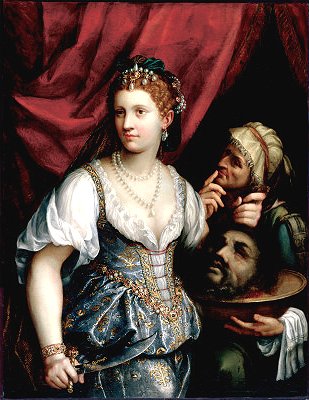 |
|
Judith with the Head of Holofernes
by Fede Galizia, 1578 - 1630
Milan, 1596
by Lin Vertefeuille. 2000
Artist:
Fede was the daughter of painter, Nunzio Galizia. She was a precocious student of her
father and became well known and popular in her own right as a painter of portraits and
religious compositions. Her style is from the naturalistic traditions of the Renaissance
and many of her portraits are sharply realistic. She received several public commissions
for altar pieces in Milanese churches. However the major part of her surviving works are
still lifes, a relatively new genre at that time. She is credited with having the first
dated still life, 1602, by an Italian artist. Her still lifes were normally frontal,
symmetrical featuring a basket, porcelain bowl or fruit stand usually containing one kind
of fruit. However in some of her works other fruits were placed on a counter in contrast
possibly suggesting vanitas. She preferred simple still life compositions and has been
compared to Francisco de Zurbaran. She painted Judith with the Head of Holofernes at age
eighteen.
Subject:
The story of Judith with the Head of Holofernes comes from the Book of Judith in the
Apocrypha and was a popular subject with private collectors and painters at that time.
Women identified with |
Judith as a heroine and men sometimes viewed the story as a warning - not
to lose your head over a woman!
Judith was a wealthy Jewish widow whose village was being attacked by the
Assyrian Army led by its general, Holofernes. Judith in her finest attire and jewels, with
her maid pretends to defect to the enemy camp. Holofernes is quite taken by her, they
party and she makes sure he consumes much alcohol. They withdraw to his tent and he falls
asleep in a drunken stupor. Judith then severs his head with a sword. Her maid hides his
head in a sack and they return to her village. In the morning the Assyrians discover their
general murdered and leave in disarray thus sparing Judith's village.
Painting:
Her skill and background as a portrait painter is evident in Fede's depiction of the
scene. Judith's gown and fabric is in exquisite, rich, brocaded detail adorned in jewels.
Even her hair is ornately curled. There is a serene look on her face. Her fingers tightly
entwine in the hair of the severed head. In her other hand Judith grasps a large sharp
dagger, which Fede has shown rather than the usual sword. A basin, rather than a sack is
held under the head by her maid. If you were to cover up this gruesome sight of a severed
head, it would be a pleasant portrait of an attractive aristocratic lady. The eighteen
year old, Fede, certainly identified with Judith's bravery because she signed her name on
the blade of the dagger.
Historical Context:
There were other female artist in this period who were quite successful too.
Isabella Parasole created many decorative pieces in flower and leaf designs and did
botanical illustrations that were published. Antonia Uccello was another Renaissance
female artist although little is known about her work. Marietta Tintoretto worked on the
backgrounds of her father's huge canvases and her portraiture was much admired, however
her father wouldn't let her go away to other courts to paint and married her off to a
venetian jeweler to keep her close to home. Artemisia Gentileschi's career spanned over
forty years in Italy and England. She painted two different scenes of Judith and they are
very dramatic, violent and realistic actually depicting Judith in the act of holding down
Holofernes while she cut off his head! Elisabetta Sirani, from a wealthy and supportive
family, also painted Judith ,but in a gentle classical manner. She kept a written record
of more than 150 of her works before her death at age twenty-six and was a teacher and
role model for aspiring woman artists.
|
